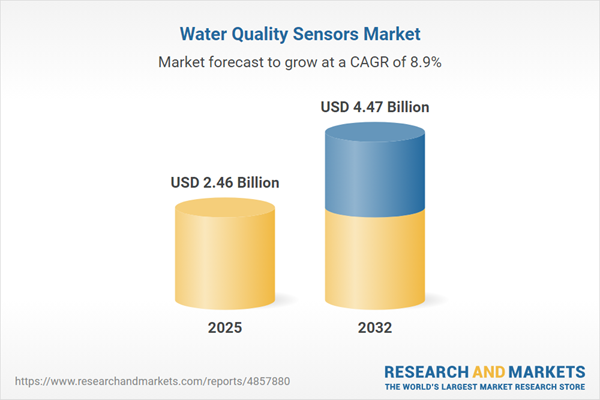Speak directly to the analyst to clarify any post sales queries you may have.
Senior leaders face mounting pressure to safeguard operational integrity and compliance through advanced water quality monitoring. Evolving regulatory demands and rising sustainability expectations are steering organizations toward adopting sophisticated water quality sensors that deliver real-time, data-driven insights.
Market Snapshot: Water Quality Sensors Market Growth Trajectory
The global water quality sensors market is on a strong upward path, expanding from USD 2.26 billion in 2024 to USD 2.46 billion in 2025 and forecast to reach USD 4.47 billion by 2032, representing a compound annual growth rate (CAGR) of 8.89%. This growth is being propelled by tightening environmental policies and heightened sustainability initiatives. Sectors including manufacturing, utilities, and municipal operators are all increasing their investments. Innovations in microelectronics and modern sensor fabrication are expanding the accessibility of reliable monitoring solutions for both onsite and stationary applications. As data-centric operational models become standard, organizations benefit from enhanced capabilities to mitigate water quality risks and optimize their processes.
Scope & Segmentation of the Water Quality Sensors Market
- Product Types: Laboratory instruments, including benchtop and desktop models, support rigorous analytical needs. Portable devices such as handheld and wearable sensors enable swift, on-site water quality checks for rapid decision-making.
- Technology: State-of-the-art offerings range from biosensors—including DNA-based, enzymatic, and microbial technologies—to electrochemical sensors, such as amperometric, coulometric, and potentiometric models. Optical solutions also play a pivotal role, with tools leveraging fluorescence, NIR, and UV-VIS spectrums for precise monitoring.
- End User Categories: The user base is diverse, encompassing commercial properties, heavy and light industrial manufacturers, utility providers, municipal utilities, and residential segments, each with unique requirements for water quality oversight.
- Regional Coverage: The market features significant activity across the Americas (including the United States, Canada, Mexico, Brazil, Argentina, Chile, Colombia, Peru), Europe (including the United Kingdom, Germany, France, Russia, Italy, Spain, Netherlands, Sweden, Poland, Switzerland), the Middle East (featuring the United Arab Emirates, Saudi Arabia, Qatar, Turkey, Israel), Africa (spanning South Africa, Nigeria, Egypt, Kenya), and Asia-Pacific (including China, India, Japan, Australia, South Korea, Indonesia, Thailand, Malaysia, Singapore, Taiwan).
- Company Analysis: Prominent contributors include Danaher Corporation, Xylem Inc., Thermo Fisher Scientific Inc., Endress+Hauser AG, ABB Ltd., Siemens AG, Emerson Electric Co., Honeywell International Inc., Horiba Ltd., and Yokogawa Electric Corporation, each driving progress and innovation through strategic investment and technology development.
Key Takeaways for Senior Decision-Makers
- The ongoing evolution of compliance policies and technological advances is embedding real-time water monitoring into the core operations of industries with stringent requirements.
- Modern sensor solutions balance comprehensive laboratory analytics with practical portability for real-time, on-site incident responses and uninterrupted facility supervision.
- Integrated machine learning, IoT connectivity, and cloud-based analytics enable organizations to move from reactive to predictive water management, lowering their overall risk exposure.
- Advances in devices such as self-calibrating sensors and enhanced resistance to biofouling reduce maintenance demands and extend operational lifespans, the result of collaboration among technology vendors, academic partners, and regulators.
- Entities are restructuring procurement and supply chain practices, including nearshoring and diversifying supplier pools, to reduce exposure to global supply interruptions.
Impact of United States Tariff Policies on Supply Chains
Recent tariff adjustments impacting both water quality sensor parts and completed units in the United States are prompting manufacturers to reconsider supply chain logistics. Shifts in policy have led many organizations to expand domestic production or develop new supplier relationships, supporting improved resilience and the ability to address continued geopolitical shifts.
Methodology & Data Sources
This analysis integrates direct interviews with manufacturers and agencies alongside a detailed review of technical publications, patents, and regulatory records. Data accuracy is assured through peer review and industry expert validation, enabling confident strategic planning for decision-makers.
Why This Report Matters
- Presents strategic insights for technology planning and regulatory adaptation in the water quality sensors market, essential for long-term competitive positioning.
- Delivers detailed segmentation and region-specific findings, guiding organizations in identifying target growth markets and aligning product strategies.
- Equips executives to benchmark practices, anticipate potential disruptions, and seize new business opportunities with clarity and assurance.
Conclusion
This report supplies actionable intelligence and thorough market perspectives, guiding industry leaders through regulatory change and operational transformation in the water quality sensor landscape.
Additional Product Information:
- Purchase of this report includes 1 year online access with quarterly updates.
- This report can be updated on request. Please contact our Customer Experience team using the Ask a Question widget on our website.
Table of Contents
3. Executive Summary
4. Market Overview
7. Cumulative Impact of Artificial Intelligence 2025
List of Figures
Samples

LOADING...
Companies Mentioned
The key companies profiled in this Water Quality Sensors market report include:- Danaher Corporation
- Xylem Inc.
- Thermo Fisher Scientific Inc.
- Endress+Hauser AG
- ABB Ltd.
- Siemens AG
- Emerson Electric Co.
- Honeywell International Inc.
- Horiba Ltd.
- Yokogawa Electric Corporation
Table Information
| Report Attribute | Details |
|---|---|
| No. of Pages | 194 |
| Published | October 2025 |
| Forecast Period | 2025 - 2032 |
| Estimated Market Value ( USD | $ 2.46 Billion |
| Forecasted Market Value ( USD | $ 4.47 Billion |
| Compound Annual Growth Rate | 8.8% |
| Regions Covered | Global |
| No. of Companies Mentioned | 11 |









